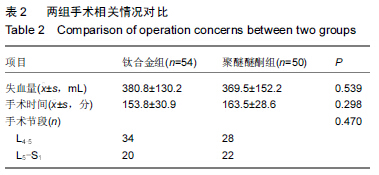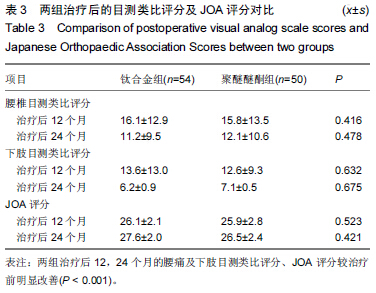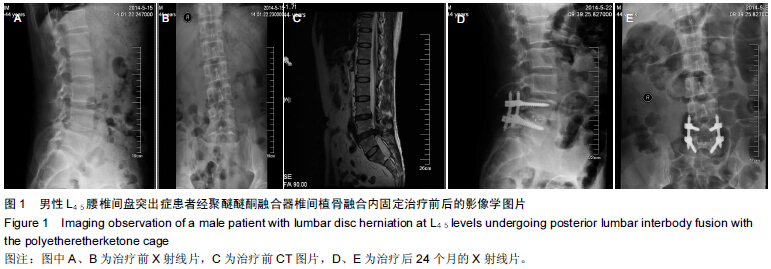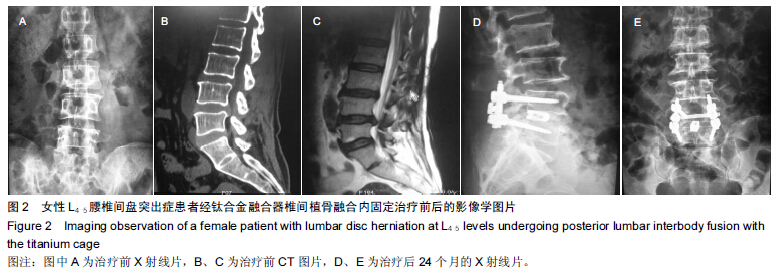|
[1] Brantigan JW,Steffee AD,Lewis ML,et al.Lumbar interbody fusion using the Brantigan I/F cage for posterior lumbar interbody fusion and the variable pedicle screw placement system: two-year results from a Food and Drug Administration investigational device exemption clinical trial.Spine (Phila Pa 1976).2000;25:1437-1446.
[2] Hashimoto T,Shigenobu K,Kanayama M,et al.Clinical results of single level posterior lumbar interbody fusion using the Brantigan I/F carbon cage filled with a mixture of local morselized bone and bioactive ceramic granules.Spine (Phila Pa 1976). 2002;27:258-262.
[3] Galbusera F,Bellini CM,Anasetti F,et al. Rigid and flexible spinal stabilization devices: A biomechanical comparison.Med Eng Phys.2011;33:490-496.
[4] Smit TH,Muller R,van Dijk M,et al.Changes in bone architecture during spinal fusion: Three years follow-up and the role of cage stiffness.Spine (Phila Pa 1976). 2003;28: 1802-1808, discussion 1809.
[5] Vadapalli S,Sairyo K,Goel VK,et al.Biomechanical rationale for using polyetheretherketone spacers for lumbar interbody fusion-a finite element study. Spine (Phila Pa 1976).2006; 31:992-998.
[6] Lee JH,Lee JH,Park JW,et al.Fusion rates of a morselized local bone graft in polyetheretherketone cages in posterior lumbar interbody fusion by quantitative analysis using consecutive three-dimensional computed tomography scans. Spine J.2011;11:647-653.
[7] Schimmel JJP,Poeschmann MS,Horsting PP,et al.PEEK cages in lumbar fusion:mid-term clinical outcome and radiological fusion.J Spinal Disord Tech.2012.[Epub ahead of print]doi: 10.1097/BSD.0b013e31826eaf74.
[8] Chen Y,Wang X,Lu X,et al.Comparison of titanium and polyetheretherketone (PEEK) cages in the surgical treatment of multilevel cervical spondylotic myelopathy: a prospective, randomized, control study with over 7-year follow-up.Eur Spine J.2013;22(7):1539-1546.
[9] Navarrete RO,Gittens RA,Schneider JM,et al.Osteoblasts exhibit a more differentiated phenotype and increased bone morphogenetic protein production on titanium alloy substrates than on poly-ether-ether-ketone. Spine J. 2012;12:265-272.
[10] Kurtz SM,Devine JN.PEEK biomaterials in trauma, orthopedic, and spinal implants.Biomaterials.2007;28:4845-4869.
[11] Brantigan JW,Steffee AD,Lewis ML,et al.Lumbar interbody fusion using the Brantigan I/F cage for posterior lumbar interbody fusion and the variable pedicle screw placement system. Spine (Phila Pa 1976).2000;25:1437-1446.
[12] Cook SD,Patron LP,Christakis PM,et al.Comparison of methods for determining the presence and extent of anterior lumbar interbody fusion. Spine (Phila Pa 1976).2004;29: 118-123.
[13] Cutler AR,Siddiqui S,Mohan AL,et al.Comparison of polyetheretherketone cages with femoral cortical bone allograft as a single-piece interbody spacer in transforaminal lumbar interbody fusion.J Neurosurg Spine.2006;5:534-539.
[14] Kraiwattanapong C,Boden SD,Louis-Ugbo J,et al.Comparison of Healos/bone marrow to INFUSE(rhBMP-2/ACS) with a collagenceramic sponge bulking agent as graft substitutes for lumbar spine fusion.Spine. 2005;30:1001-7; discussion 7.
[15] Rihn JA, Kirkpatrick K, Albert TJ. Graft options in posterolateral and posterior interbody lumbar fusion.Spine (Phila Pa 1976).2010;35:1629-1639.
[16] Tokuhashi Y,Ajiro Y,Umezawa N.Subsidence of metal interbody cage after posterior lumbar interbody fusion with pedicle screw fixation.Orthopedics.2009;32:32-34.
[17] Helgeson md,Lehman RA,Patzkowski JC,et al.Adjacent vertebral body osteolysis with bone morphologic protein use in transforaminal lumbar interbody fusion.Spine J.2011;11(6): 507-510.
[18] Choi JY,Sung KH.Subsidence after anterior lumbar interbody fusion using paired stand-alone rectangular cages.Eur Spine J.2006;15:16-22.
[19] Kim MC,Chung HT,Cho JL,et al.Subsidence of Polyetheretherketone Cage After Minimally Invasive Transforaminal Lumbar Interbody Fusion.J Spinal Disord Tech. 2013;26(2):87-92.
[20] Nemoto O,Asazuma T,Yato Y,et al.Comparison of fusion rates following transforaminal lumbar interbody fusion using polyetheretherketone cages or titanium cages with transpedicular instrumentation.Eur Spine J. 2014;23(10): 2150-2155.
[21] Ha SK,Park JY,Kim SH,et al.Radiologic assessment of subsidence in stand-alone cervical polyetheretherketone (PEEK) cage. J Korean Neurosurg Soc.2008;44:370-374.
[22] Beutler WJ,Peppelman WC Jr.Anterior lumbar fusion with paired BAK standard and paired BAK Proximity cages: subsidence incidence, subsidence factors, and clinical outcome. Spine J.2003;3:289-293. |




